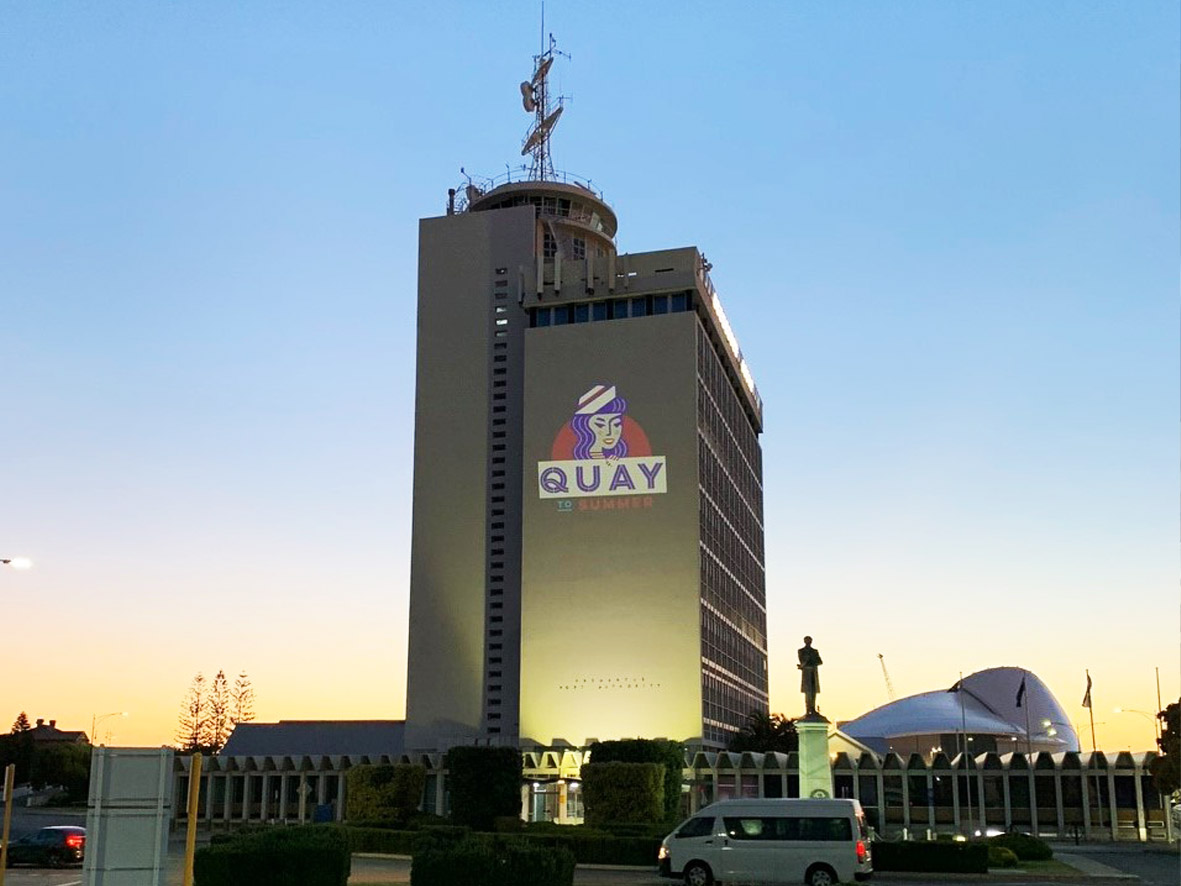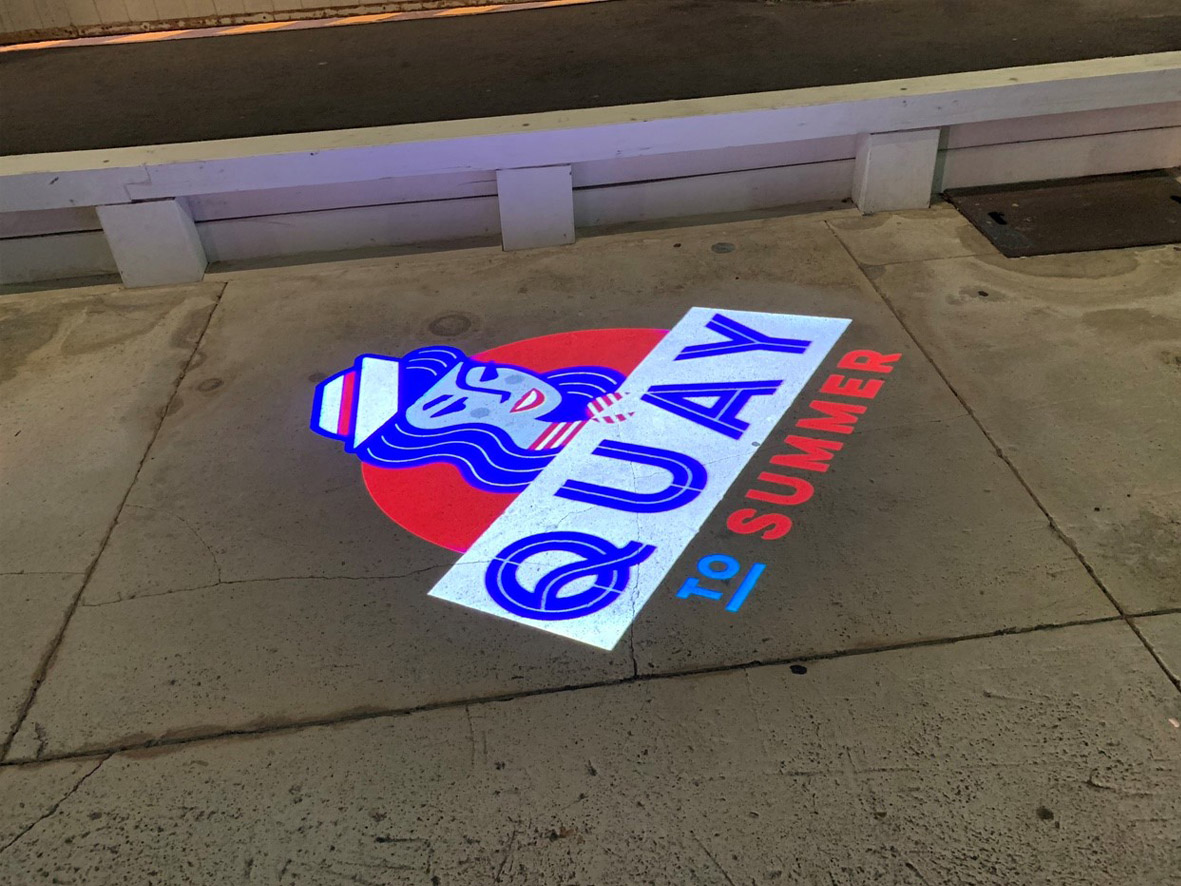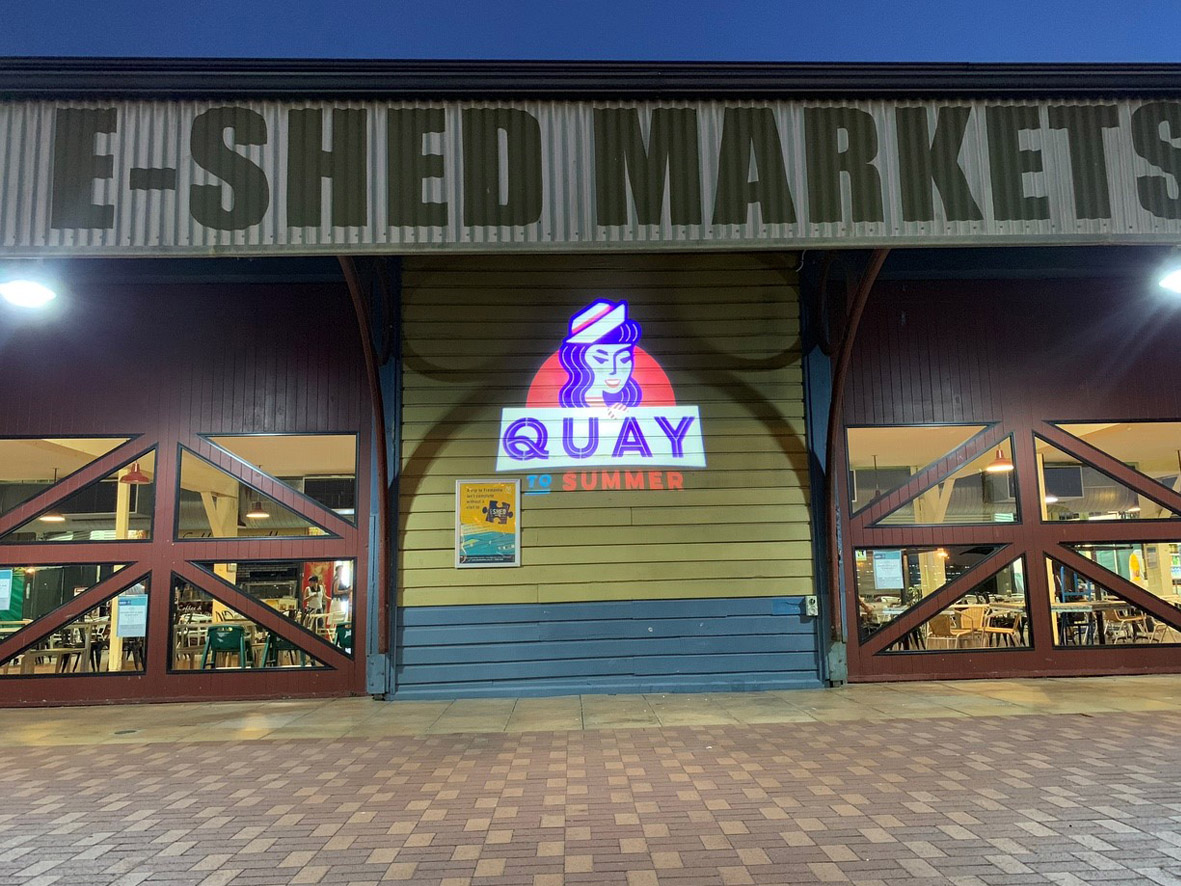Guide to Choosing Your Gobo Projector
Gobo projectors can be an effective way of communicating your message. However, when deciding on a gobo projector, we understand it can be a little daunting. There are a lot of options on the market, and when it comes to image projection, it is not a ‘one size fits all’ situation. So, how do you know what will work for your installation?
We have put together this guide to help you understand projection and assist you in making an educated and informed decision about what gobo projector will work for your requirements.
“Quay to Summer”
Audiovisual (& client) – LUX Events Perth | Fixtures: Grand Lighting range
Before We Begin
The Basics of Gobo Projectors
A gobo is a small circular disc, of an image or logo, that when put into a gobo projector, projects the image. The design could be anything, from a simple pattern to a logo, a complex drawing, or a photographic image.
A gobo can be used to project:
- Logos, text or messages
- Abstract patterns
- Photographic images – both greyscale & colour
A gobo projector cannot:
- Project a video – This is called ‘data projection’
- Project a ‘digital’ file that has been sent from a laptop or device.
If you would like to learn more about gobos; including the different types of gobos, as well as some helpful tips and tricks check out our gobo guide.
What You Need to Consider
1. The Projection Location
This includes the environment, mounting location, projection distance as well as the surface you are projecting onto.
2. The Ambient Light Levels
This includes when your projection will be seen (daytime/night-time only), as well as how bright it is in the area.
3. The projected Image
This includes the finished projection size, as well as the design itself, including what colours are in the image.
1. the projection location
What Environment will the projector be?
This is going to tell you what type of projector you need to look at.
If you are mounting the projector outdoors, exposed to the elements, on a factory floor or in a wet area then you will need to look at outdoor rated fixtures with a minimum rating of IP65.
Where are you mounting the projector?
There are different mounting options for projectors, so where you are mounting the projector and where you are projecting onto will affect which you choose.
For example, are you wanting to recess into a ceiling projecting onto the floor? Then a recessed gobo projector may be what you are after. Or are you wanting to mount outside your shopfront under the awning projecting onto the footpath? Then an IP65 Surface Mount gobo projector be what you need.
What distance are you projecting?
This is a particularly important factor when choosing a fixture. The further away you are from the surface you are projecting onto, the brighter you need the fixture… and hence it needs to have more power.
The photos below show a 30W projector projecting at 3m and 6m. As you can see the image is not as bright.
What Kind of Surface are you projecting onto?
Be sure to also take into consideration the colour and type of surface you are projecting onto. This is a common oversight when choosing a gobo projector.
Bright surfaces like a white wall will reflect the light better, producing a brighter projection. Whereas a dark carpet will absorb the light. It does not mean you cannot project onto these surfaces, it just means you may need to go with a more powerful, and hence brighter, gobo projector, or stick to an open white projection only, as this is the brightest colour you can project.
2. The Ambient Light (lux) Levels
When will the Projection be seen?
Are you wanting the projector to be seen during the evening only? Then you may not need to go with a high-powered unit because you are not competing with any other light.
However, if you are wanting to project during the day, and competing with natural sunlight, then how much other light is in the area becomes key to how powerful you need the projector to be.
This is where the lux levels start to become particularly important!
How bright is the area (lux levels)?
How much light you have in the area is crucial to determine how bright you need the projection to be.
You measure how bright a projection surface is by measuring the lux levels, using a lux meter. There are also a few apps that although they are not as good can give you an indication on how bright the surface is.
To give you an idea on brightness levels: An office space (with artificial light) usually measures between 100-300 lux, whereas the sun is over 100,000 lux… this is why we always ask if you have natural sunlight in an area.
We have been doing this for an exceptionally long time, so if you send us through photos of the area, we can very quickly give you an indication of how bright that space is and what will work for you.
Hint: Whatever the lux is on the projection surface you want to double that. So, if your projection surface is 200 lux you want the projection to be at least 400 lux.
The photometric data on specification sheets will give you the finished lux measurements using that fixture.
3. The Projected image or Logo
What finished Projection size are you wanting?
The finished projection size is going to be determined by the distance you are projecting, and the beam angle in the fixture.
With any light the tighter the beam angle, the more concentrated the beam of light is, hence the image will be brighter (but smaller). The wider the beam angle, the more surface area the light is spread out over so although it will be bigger, it will also be duller.
Hint: When you double the size of the projection, the brightness decreases by a quarter.
So, if you want a projection that is bright AND big… then you may need to step it up to a higher-powered fixture.
Hint: Bigger is not always better with gobo projection. For footpath or indoor projections, for the most part the sweet spot is around 80cm to 100cm diameter (depending on the image).
What Image (and colours) are you projecting?
It is important to keep in mind that projecting and printing colours is vastly different!
White is the brightest colour you can project, works on all surface types and what we will typically recommend for most permanent installations. It is also your most cost-effective option.
How well your colour logo works once projected, will depend on the surface you are projecting onto (refer back to “what kind of surface are you projecting onto?” under “The Projection Location”) and also the colours in the logo itself.
We completely understand you may have brand guidelines you need to stick to; however, we will always be very honest if we think an image or colour will not work well once projected.
Once we see the design and know the details of your installation, we guide you on the best gobo solution.
Do you have a gobo Projector Enquiry?
Please fill out our questionnaire, which will help us determine the best gobo projector for your requirements.


